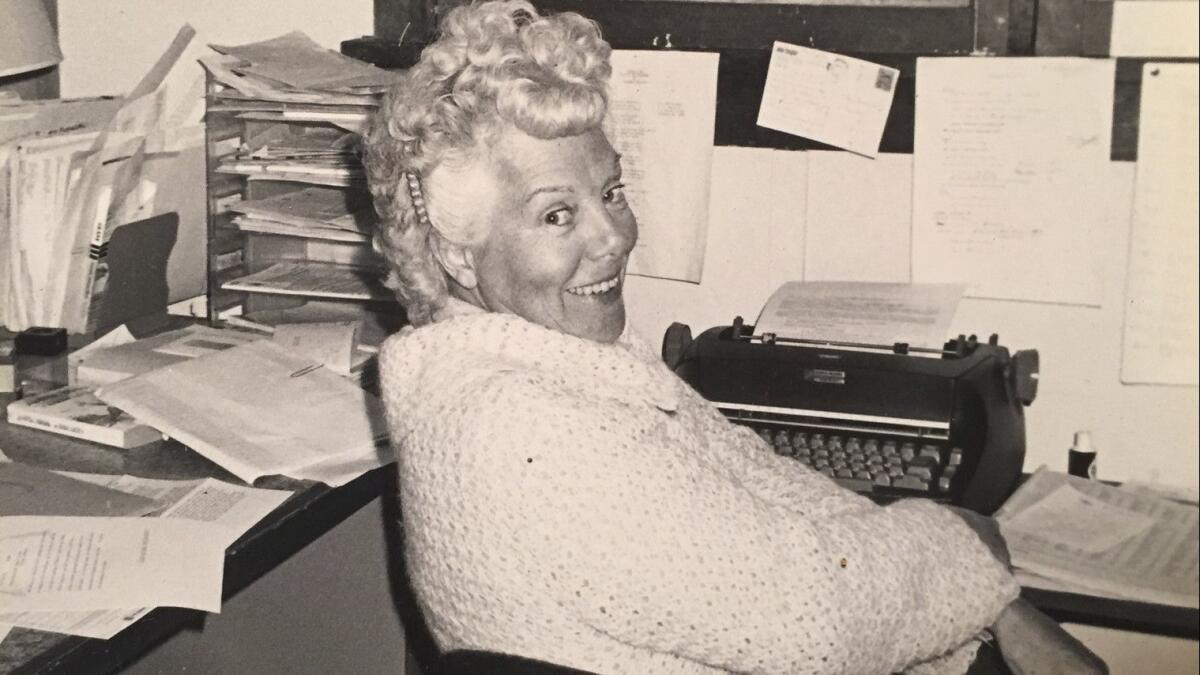Betty Ballantine, who helped invent the modern paperback, dies at 99

- Share via
Betty Ballantine, half of a groundbreaking husband-and-wife publishing team that helped invent the modern paperback and vastly expand the market for science fiction and other genres through such bestsellers as “The Hobbit” and “Fahrenheit 451,” has died.
Ballantine died Tuesday at her home in Bearsville, N.Y., her granddaughter, Katharyn Ballantine, said. She was 99 and had been in declining health.
Ballantine was just 20 and attending school in England in 1939 when she met and married 23-year-old Ian Ballantine, an American at the London School of Economics. Using a $500 wedding gift from her father, the Ballantines started out as importers of Penguin paperbacks from England and founded two enduring imprints: Bantam Books and Ballantine Books, both now part of Penguin Random House.
“We mourn the passing of Betty Ballantine, who with her husband Ian was a trailblazing contributor to the growth and development of book publishing and to the careers of countless authors and editors,” Random House President and Publisher Gina Centrello said in a statement.
Paperbacks had existed in the U.S. since colonial times, but in the 1930s were limited mostly to poorly made “pulp” novels. The Ballantines took advantage of new technology in production and distribution and of a clause in copyright law discovered by Ian Ballantine that waived fees on books from Britain, where quality paperbacks were much easier to find. Ian Ballantine vowed to “change the reading habits of America.”
Charging as little as a quarter, they published everything from reprints of Mark Twain novels to paperbacks of contemporary bestsellers. They helped establish the paperback market for science fiction, Westerns and other genres, releasing original works and reprints by J.R.R. Tolkien, Arthur C. Clarke and H.P. Lovecraft, among others. Along with such contemporaries as Pocket Books, which launched its own line in 1939, they made their publications widely available — whether in drugstores, railroad stations or other nontraditional outlets. They issued some paperbacks simultaneously with the hardcover, instead of waiting several months or longer.
Their most lucrative publications came in the 1950s and ’60s, when they were running Ballantine Books.
Ballantine editor Stanley Kauffmann, who later became the film critic for the New Republic, acquired “Fahrenheit 451,” Ray Bradbury’s dystopian classic that came out in 1953. Years later, a switchboard operator at Ballantine had been reading a hardcover edition of Tolkien’s “The Hobbit” and recommended it to the Ballantines. They offered Tolkien’s publisher, Houghton Mifflin, $2,500 each for paperback rights to “The Hobbit” and the three “Lord of the Rings” novels. Houghton Mifflin initially declined, but reconsidered when pirated editions began appearing. Rights were granted to Ballantine, which on the back of the books printed a note from Tolkien himself: “This paperback edition, and no other, has been published with my consent and co-operation. Those who approve of courtesy (at least) to living authors will purchase it and no other.” Bookstores and readers, meanwhile, boycotted unauthorized texts.
“The whole science-fiction fraternity got behind the book; this was their meat and drink,” Betty Ballantine recalled, according to Al Silverman’s “The Time of Their Lives,” a publishing history which came out in 2008.
The Ballantines sold their company in the late 1960s, and ended up working at what is now Penguin Random House. Betty Ballantine’s projects included editing Shirley MacLaine’s bestselling “Out On a Limb” and writing a fantasy novel, “The Secret Oceans,” published in 1994. The Ballantines received numerous honorary awards and were voted into the Science Fiction Hall of Fame in 2008.
“We really, truly wanted and did publish books that mattered,” Ballantine told the science-fiction and fantasy magazine Locus in 2002. “And science fiction matters, because it’s of the mind, it predicts, it thinks, it says, ‘Look at what’s happening here. If that’s what’s happening here and now, what’s it going to look like 10 years from now, 50 years from now, or 2,000 years from now?’ It’s a form of magic. Not abracadabra or wizardry. It is the minds of humankind that make this magic.”
Ian Ballantine died in 1995. Their son, Richard Ballantine, a popular cycling writer and enthusiast, died in 2013. The Ballantines had three grandchildren.
Betty Ballantine, the daughter of a British colonial officer, was born Elizabeth Jones in India in 1919. She remembered being taught to read by her father at age 3 and was so absorbed by Charles Dickens and other authors that she would acknowledge having a hard time understanding that the characters in their books weren’t real. Ian Ballantine was the cousin of one of her classmates in England.
Soon after marrying, the two traveled by ship back to his native New York. They established the U.S. division of Penguin Books and worked out of their apartment. In 1945, they founded Bantam Books, then part of Grosset & Dunlap, and went into business for themselves seven years later with Ballantine Books.
One memorable Ballantine release was inspired by a hoax. In 1956, nighttime radio personality Jean Shepherd was telling listeners that they should ask for a new novel called “I, Libertine,” by Frederick R. Ewing. Bestsellers at the time were based in part on requests at bookstores, and demand was so high that “I, Libertine” appeared on some lists.
But, as Shepherd’s fans knew, and the public only later found out, neither book nor author existed. So Ian Ballantine convinced a friend, science-fiction writer Theodore Sturgeon, to write — and write quickly — an actual “I, Libertine.” Shepherd, who provided the book’s outline, recalled years later that Sturgeon worked so hard he fell asleep before he finished the manuscript. Betty Ballantine stepped in and handled the last chapter, and “I, Libertine” went to print.
Italie writes for the Associated Press.
More to Read
Start your day right
Sign up for Essential California for the L.A. Times biggest news, features and recommendations in your inbox six days a week.
You may occasionally receive promotional content from the Los Angeles Times.



